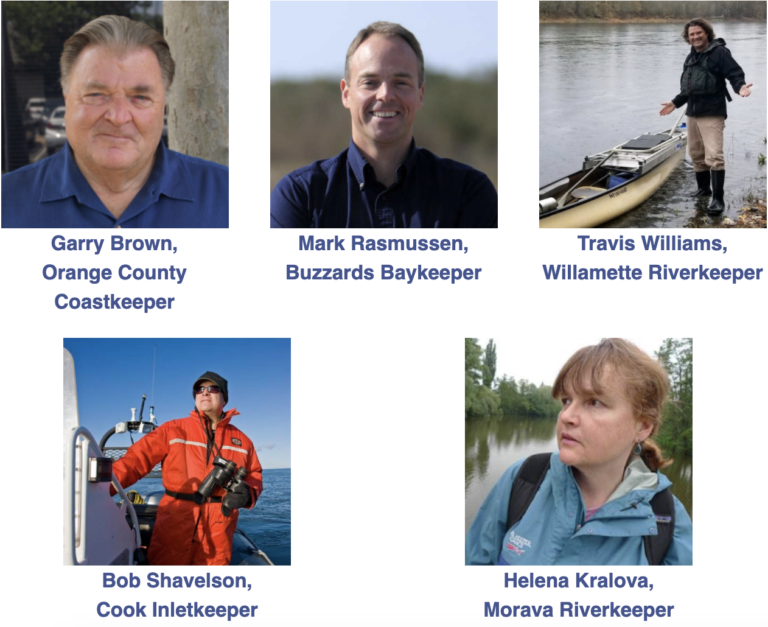In it for the Long Haul: Saluting Waterkeeper Heroes
By: Marc Yaggi

In a world where so much seems to be measured in dollars and cents, (or Euros or Kenyan Shillings or Peruvian Sols), we quantify our work differently.
As I think about this year’s winners of the Hero Awards, people who have stayed with our movement for at least 20 years, I measure their impact in eelgrass, divers, storm drains, lawsuits fought; in swimmers, in float trips, in test strips, in alewives.
Just a taste of what these Hero Award winners have accomplished:
- Orange County Coastkeeper Garry Brown’s efforts resulted in 40,000 students connecting to the environment through hands-on field trips.
- Buzzards Baykeeper Mark Rasmussen’s work led to the protection of 7,000 acres of land throughout the watershed.
- Willamette Riverkeeper Travis Williams’ vision has resulted in thousands of people taking paddling trips on the Willamette, learning to love and protect the river.
- Cook Inletkeeper Bob Shavelson’s advocacy has helped bring together Alaskans from all walks of life in opposition to the proposed Pebble Mine.
- Helena Kralova, our much loved and much missed Morava Riverkeeper, taught a generation of students in the Czech Republic how to monitor water quality. Helena, who died of cancer in 2019, worked on issues including flood control and river restoration, and river cleanups.
(How about the eelgrass, divers, and storm drains? Orange County Coastkeeper worked to plant 1,280 square meters of eelgrass, trained 130 volunteer divers to plant kelp, and advocated for $58 million in stormwater capture systems.)
But measurements don’t tell the whole story. Many of their achievements are unquantified, and unquantifiable. Waterkeepers, like all activists, throw off sparks; we may never know where those sparks land.
In her book, “Hope in the Dark,” the author Rebecca Solnit recounts a story from the Women Strike for Peace movement, a group focused on winning a ban on above-ground nuclear testing after radioactive fallout showed up in mother’s milk and baby teeth.
One woman recounted protesting outside the White House in the rain, feeling futile and foolish. “Years later,” Solnit writes, “she heard Dr. Benjamin Spock — who had become one of the most high-profile activists on the issue — say that the turning point for him was spotting a small group of women standing in the rain, protesting at the White House. If they were so passionately committed, he thought, he should give the issue more consideration himself.” The U.S, the United Kingdom, and the Soviet Union signed a treaty banning above-ground nuclear tests in 1963.
I include this here because, as you all know too well, our struggles are long.
Travis, for instance, spent 17 years leading the charge to clean up the Portland Harbor Superfund site. Bob has been working to mitigate the toxic after-effects of the Exxon Valdez oil spill even longer. Thirty-one years later, oil remains on some beaches. How do you measure the lost sleep, the missed dinners, the late-night phone calls from all those years?
One way to measure them is in the potential good they’ll do. After all, these long fights can pay off with big wins.
Court decisions and corporate announcements this month spelling the end to three U.S. pipelines strongly contested by Waterkeepers are a great, and greatly heartening, example. As Outside magazine aptly put it, in a headline, This Week’s Pipeline Wins Were Decades in the Making.
We see that with our Hero Award winners, too.
Mark, for instance, waged a 10-year fight with the town of Marion, Mass. about the three unlined cesspools where the town pumped sewage. The waste lagoons were leaching contaminants and nitrogen pollution into groundwater, as well as Sippican Harbor, the Sippican River, and Aucoot Cove.
Buzzards Baykeeper first conducted a study in 2010, with the town’s cooperation, to confirm the lagoons were unlined, and that they were polluting groundwater, which was contaminating nearby waterways. When the town declined to fix the problem, Mark and his team went first to the federal Environmental Protection Agency. The EPA issued a permit that would have solved the problem, but the town appealed. Then, Mark and his team went to the state Department of Environmental Protection. Months passed. Finally, Buzzards Baykeeper went to State Court.
At any stage in this decade-long fight, Buzzards Baykeeper could have stood down. Mark and his team could have simply thrown up their hands and walked away.
But that’s not the Waterkeeper way.
Instead, Mark and his team stuck it out.
Last year, after a decade of work, the town and the state Department of Environmental Protection brokered a settlement that ends the nitrogen pollution from the lagoons. Marion agreed to discontinue the discharge from the lagoons by lining the primary lagoon, maintaining the second lagoon as a dry basin (only to be used in emergencies), and abandoning the use of the third and largest lagoon.
When the settlement was announced, Mark told a local newspaper that he “couldn’t be happier with the solution. I’m frustrated that it took this long. But a fifty-year-old pollution source is getting shut down.”
Now, he and his colleagues are working to entice the town to be part of a regional shared wastewater treatment plant.
If that happens, how could we quantify the impact? Maybe in sunsets and fishing outings and beach picnics at Sippican Harbor, the Sippican River, and Aucoot Cove, the waterways Mark and his colleagues worked so long and so hard to protect.
In thanks to Mark, Garry, Travis, Bob, and in Helena’s memory, I urge all of us to remember that our longest struggles might turn out, over time, to be our most rewarding.